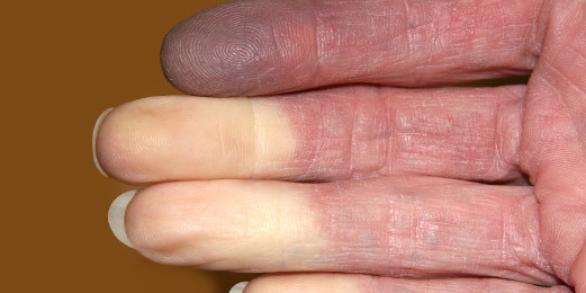We're hiring ! Join us and make a difference in our hospitals
Raynaud’s disease

What is Raynaud’s disease?
Raynaud’s disease is a disorder that affects the blood circulation, principally in the fingers and toes but sometimes in the ears, nipples, knees or nose.
It is characterised by a vasospasm – sudden constrictions of the blood vessels that considerably reduce the blood flow to the extremities – most often triggered by an exposure to cold but also by emotional stress. It can exist as an isolated condition (primary Raynaud’s disease), in which case it is observed more frequently in women and people living in colder climates. The exact cause of primary Raynaud’s disease is not known.
Raynaud’s disease also occurs in men and women with autoimmune diseases, diseases of the conjunctive tissue and also other diseases, most notably:
- Systemic scleroderma
- Disseminated lupus erythematosis
- Sjögren’s disease
- Rheumatoid polyarthritis
- Polymyositis
- Pulmonary hypertension
- Buerger’s disease (thromboangiitis obliterans)
In these cases one speaks of secondary Raynaud’s disease.
What are the risk factors?
Although we don’t know why certain persons develop Raynaud’s disease, certain risk factors are known:
- Pre-existing connective tissue
- Autoimmune disease
- Smoking
- Repetitive pressure exercised on the hands, by using vibrating tools for example (electric tools)
- Injuries or traumas
- Exposure to chemical products
- Side effects of certain medicines (beta blockers)
- Etc.
Symptoms and diagnosis
There are some very frequent symptoms encountered in Raynaud’s disease patients but each patient can experience different symptoms. The fingers and toes turn white, then blue – generally after having been exposed to cold air or cold objects, or after having suffered stress – and then turn red when warmed up again. In serious cases, sores develop at the ends of the fingers or toes. In rare cases the fingers or toes can become infected or gangrenous, requiring amputation in the absence of treatment.
How to diagnose Raynaud’s disease ?
Patients in our medical clinic are initially assessed by a rheumatologist and, depending on the severity, they can also be examined by a vascular specialist. A large part of the diagnosis will focus on assessing the symptoms. In addition to a complete medical history and a medical examination, our team will generally order at least one type of blood test. A patient may also undergo a cold provocation test to highlight the colour changes in the hands or feet. With secondary Raynaud’s disease it is also important to identify - and treat- the underlying autoimmune disease that may be at the origin of the Raynaud’s disease (for example systemic sclerodermia: see the Erasmus Hospital’s systemic sclerodermia reference centre).
An examination by capillaroscopy is carried out. This non-invasive and painless examination makes it possible to visualise the capillaries in the nail bed. In the case of secondary Raynaud’s disease, as in the case of systemic sclerodermia, a reduction in the number of capillaries is observed as well as the presence of dilated capillaries.
Treatment
After an in-depth evaluation the team of doctors will draw up a treatment plan based on the type and extent of the disease, the general health status of the patient and the patient’s preferences.
Although there is no cure for Raynaud’s disease, it can normally be managed with appropriate treatment, such as:
Lifestyle changes:
- Limit exposure to the cold by dressing warmly: gloves, socks, scarf, hat and several layers
- Stop smoking to improve circulation and your health in general
- Avoid the use of vibrating tools.
Medical treatment
- Alpha blockers suppress the response of the sympathetic nervous system that leads to vasoconstriction (narrowing of the blood vessels)
- Other medicines improve the blood flow to the fingers and toes by dilating the blood vessels. These include calcium channel inhibitors and phosphodiesterase inhibitors.
- Avoid using beta blockers, generally used for treating high blood pressure and that slow the heart rate and reduce the blood flow to extremities
- For patients who do not show a sufficient response to the aforementioned medicines there can be experimental medicine options - medicines that can be used in clinical trials.